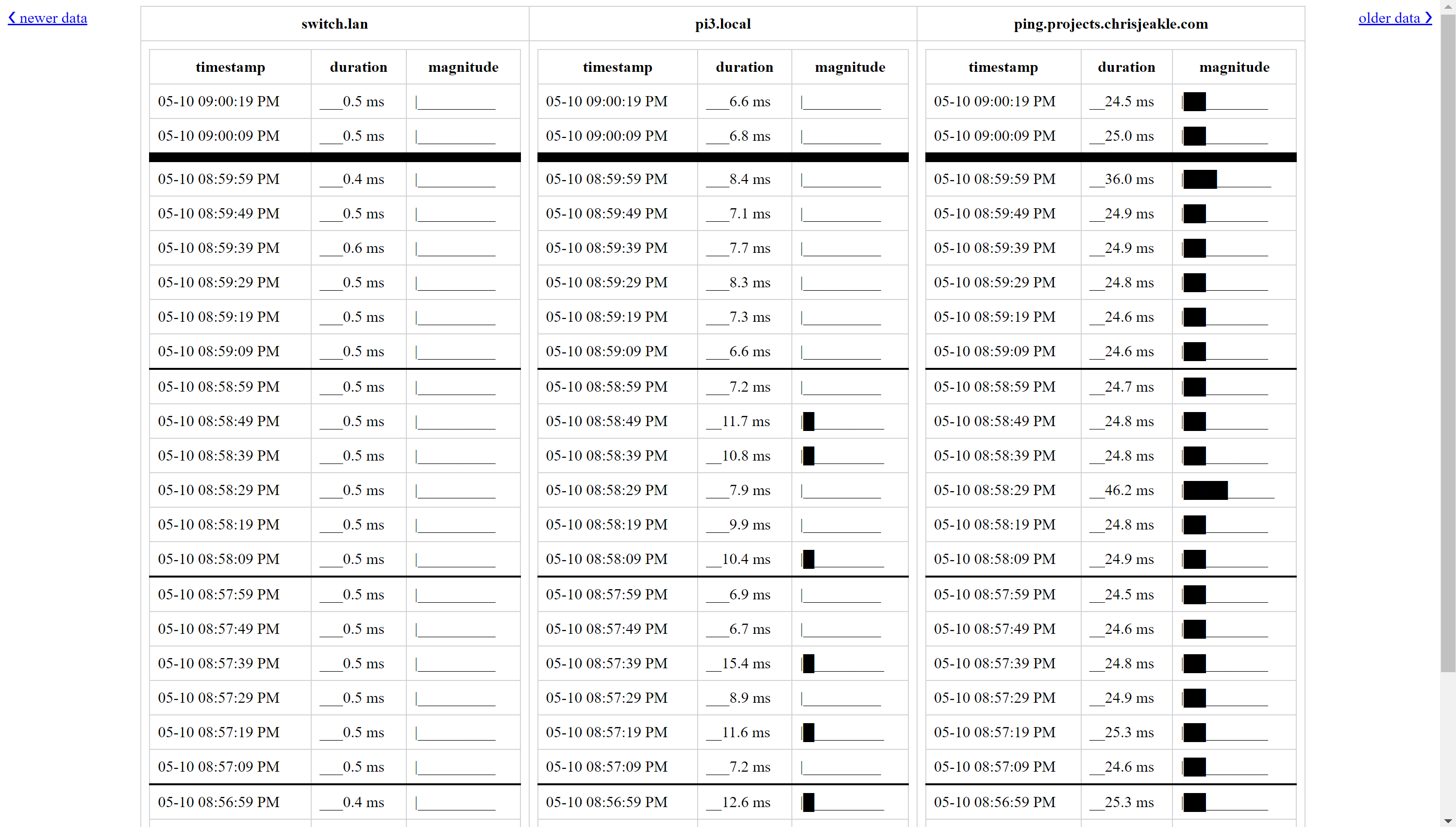Network Monitor
A utility to help monitor and assess network performance
Build
- Install
rustup:curl --proto '=https' --tlsv1.2 -sSf https://sh.rustup.rs | sh - This project uses nightly features:
rustup install nightly - Ensure you're up-to-date (
rustup update) - Build the LAN-side application:
cargo fmt --manifest-path=LAN/Cargo.toml && \ cargo +nightly build --manifest-path=LAN/Cargo.toml && \ sudo setcap cap_net_admin,cap_net_raw=eip LAN/target/debug/network-monitor - Test the LAN-side application:
LAN/target/debug/network-monitor router.local ping.projects.chrisjeakle.com- By default the UI is available at http://0.0.0.0:8180
Deploy
Web hosted latency test
- Set up the web pages:
- On the server:
ssh root@projects.chrisjeakle.com 'mkdir /var/www/html/ping/' - Upload the latency test page to the server:
scp -pr WAN/html root@projects.chrisjeakle.com:/var/www/html/ping/
- On the server:
- Configure nginx:
scp WAN/nginx/ping.conf root@projects.chrisjeakle.com:/etc/nginx/conf.d/ping.conf- On the server:
ssh root@projects.chrisjeakle.com 'service nginx reload'
- Test the config
- Ensure ICMP pings work (so the LAN tool can ping this WAN destination):
ping -c 4 ping.projects.chrisjeakle.com - Ensure there's no redirects:
curl -H 'Cache-Control: no-cache' http://ping.projects.chrisjeakle.com/ping/ -I -k curl http://ping.projects.chrisjeakle.com/ping/- Visit in a browser: http://ping.projects.chrisjeakle.com/
- Ensure ICMP pings work (so the LAN tool can ping this WAN destination):
LAN ping monitoring tool
Initial Deploy
- SSH into a LAN device to host the software
- Configure the application by editing
LAN/config.rs - Build the application
cargo +nightly build --release --manifest-path=LAN/Cargo.toml
- Copy the binary to the appropriate folder on the LAN device
sudo mkdir -p /usr/bin/network-monitor/sudo cp LAN/target/release/network-monitor /usr/bin/network-monitor/network-monitor
- Apply capabilities so the program is permitted to create raw sockets
sudo setcap cap_net_admin,cap_net_raw=eip /usr/bin/network-monitor/network-monitor- Verify it worked using:
getcap /usr/bin/network-monitor/network-monitor
- Create a new non-root user to run the service
sudo useradd --system network-monitor- Create a
systemuser, we have no need for interactive shell sessions or a home dir
- Create a
- Create a service to auto-start the application
sudo cp LAN/systemd/network-monitor.service /etc/systemd/system/network-monitor.service
- Edit the service definition to ping the hosts you want to ping
sudo vim /etc/systemd/system/network-monitor.service- Edit the command line args at the end of the
ExecStart=line under[Service]
- Enable the service and start it
sudo systemctl enable network-monitor.service && sudo systemctl start network-monitor.service- Monitor service health:
sudo systemctl status network-monitor.servicesudo journalctl -u network-monitor | less +G
- View the network ping logs in a browser at http://localhost:8180 or http://pi4.local:8180
Updates
Binary update script:
git pull && \
cargo +nightly build --release --manifest-path=LAN/Cargo.toml && \
sudo systemctl stop network-monitor.service && \
sudo cp LAN/target/release/network-monitor /usr/bin/network-monitor/ && \
sudo setcap cap_net_admin,cap_net_raw=eip /usr/bin/network-monitor/network-monitor && \
sudo systemctl start network-monitor.service && \
sudo getcap /usr/bin/network-monitor/network-monitor && \
sudo systemctl status network-monitor.service
